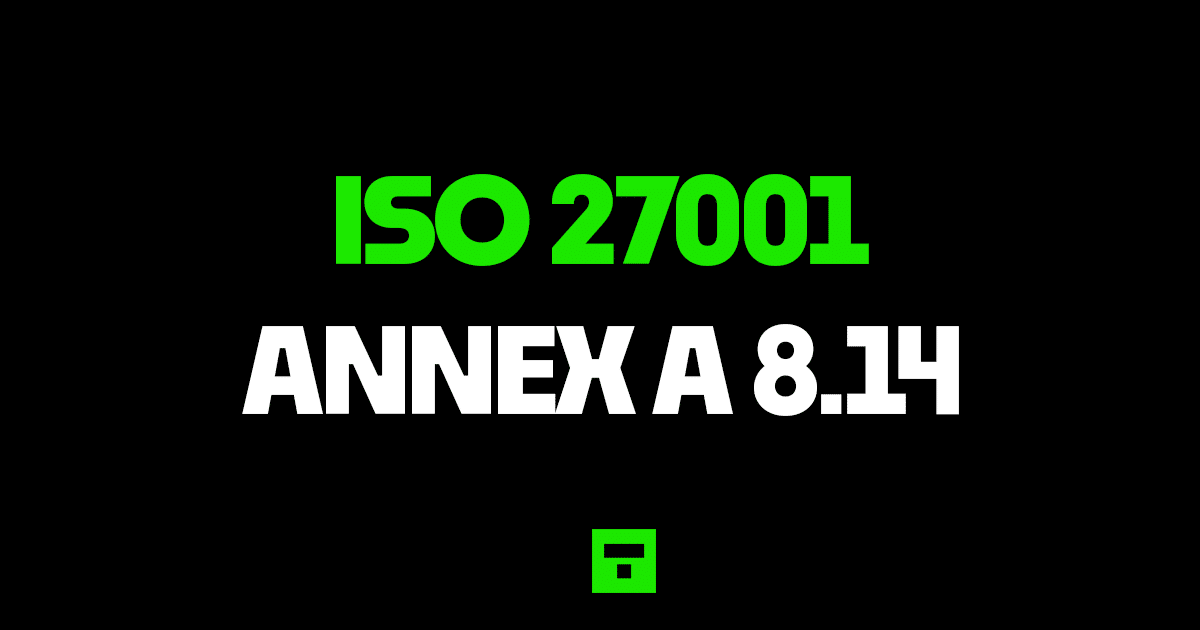Table of contents
What is ISO 27001 Redundancy of information processing facilities?
ISO 27001 Annex A 8.14 Redundancy of information processing facilities is an ISO 27001 control that requires an organisation to implement information processing facilities with redundancy built in that is sufficient enough to meet availability requirements.
Purpose
ISO 27001 Annex A 8.14 is preventive control that ensures the continuous operation of information processing facilities.
Definition
The ISO 27001 standard defines ISO 27001 Annex A 8.14 as:
ISO27001:2022 Annex A 8.14 Redundancy of Information Processing Facilities
Information processing facilities should be implemented with redundancy sufficient to meet availability
Implementation Guide
Identify Requirements
Identify what requirements you have for maintaining availability so that you can understand what you need to implement.
The best way to identify the redundancy requirements is to conduct a business impact assessment (BIA). The BIA will identify and prioritise your critical systems and data and will provide you with time scales for how quickly they should be recovered. This in turn will inform your approach to redundancy.
Design and Implement Redundancy
This is where you will need the guidance of your subject matter experts in the technologies that you have. Usually there is an element of duplication that meets redundancy requirements and then implementing the processes and procedures to activate those redundant components.
Implement Alerts
You will want to have alerts in place that notify you when any element that is covered under redundancy fails so that you can respond and run the processes and procedures you have in place to recover.
Cloud Computing
Cloud computing allows you various advantages including the the potential to have multiple live versions of information processing facilities, multiple separate physical locations, automatic failover, load balancing and more. Work with the subject matter experts to see what you can leverage to meet your requirements.
Testing
It goes without saying that you should test and evidence your testing for activating redundancy. This is usually as part of your business continuity and disaster recovery testing.
Related Controls
ISO 27001 Annex A 5.30 ICT Readiness for business continuity
ISO 27001 Templates
DO IT YOURSELF ISO 27001
All the templates, tools, support and knowledge you need to do it yourself.
ISO 27001 templates have the advantage of being a massive boost that can save time and money so before we get into the implementation guide we consider these pre written templates that will sky rocket your implementation. This ISO 27001 Toolkit has been specifically designed so you can DIY your ISO 27001 certification, build your ISMS in a week and be ISO 27001 certification ready in 30 days.
How to comply
To comply with ISO 27001 Annex A 8.14 you are going to implement the ‘how’ to the ‘what’ the control is expecting.
In short measure you are going to:
- Understand and record the legal, regulatory and contractual requirements you have for data
- Conduct a risk assessment
- Based on the legal, regulatory, contractual requirements and the risk assessment you will implement a redundancy solution
- Document and implement your processes and technical implementations for redundancy
- Check that the controls are working by conducting internal audits
What will an auditor check?
The audit is going to check a number of areas. Lets go through the main ones
That you have documentation
What this means is that you need to show that you have documented your legal, regulatory and contractual requirements for information and that you have taken this into account when building your information processing facilities redundancy. Where data protection laws exist that you have documented what those laws are and what those requirements are. That you have an information classification scheme and a topic specific policy for access control and that you have documented your information redundancy taking all of this into account.
That you have have implemented redundancy appropriately
They will look at systems to seek evidence of information processing facilities redundancy, testing and recovery. They want to see evidence of tests, the results of tests and any continual improvement you conducted as a result of those tests.
That you have conducted internal audits
The audit will want to see that you have tested the controls and evidenced that they are operating. This is usually in the form of the required internal audits. They will check the records and outputs of those internal audits.
Top 3 Mistakes People Make
In my experience, the top 3 mistakes people make for ISO 27001 Annex A 8.14 Redundancy of information processing facilities are
You have not tested
This is a common mistake we see. That you have not tested that you can recover and activate your redundancy solution. Sometimes you did a recovery test but it was a long time ago, or it was a partial recovery and therefore you have no actual evidence that your redundancy solution can be implemented to a point the organisation is operational again within the time frames and to the point in time that was agreed.
You don’t know your legal obligations
This is a massive mistake that we see, where people assume ISO 27001 is just information security and forget that it also checks that appropriate laws are being followed, and in particular data protection laws. Cost saving by not having a data protection expert or ignoring data protection law entirely is a common mistake we see people make when cutting corners and saving costs. Duplicating data and having redundancy, in particular personal information, can get you in a lot of hot water depending how you implement it.
Your document and version control is wrong
Keeping your document version control up to date, making sure that version numbers match where used, having a review evidenced in the last 12 months, having documents that have no comments in are all good practices.


